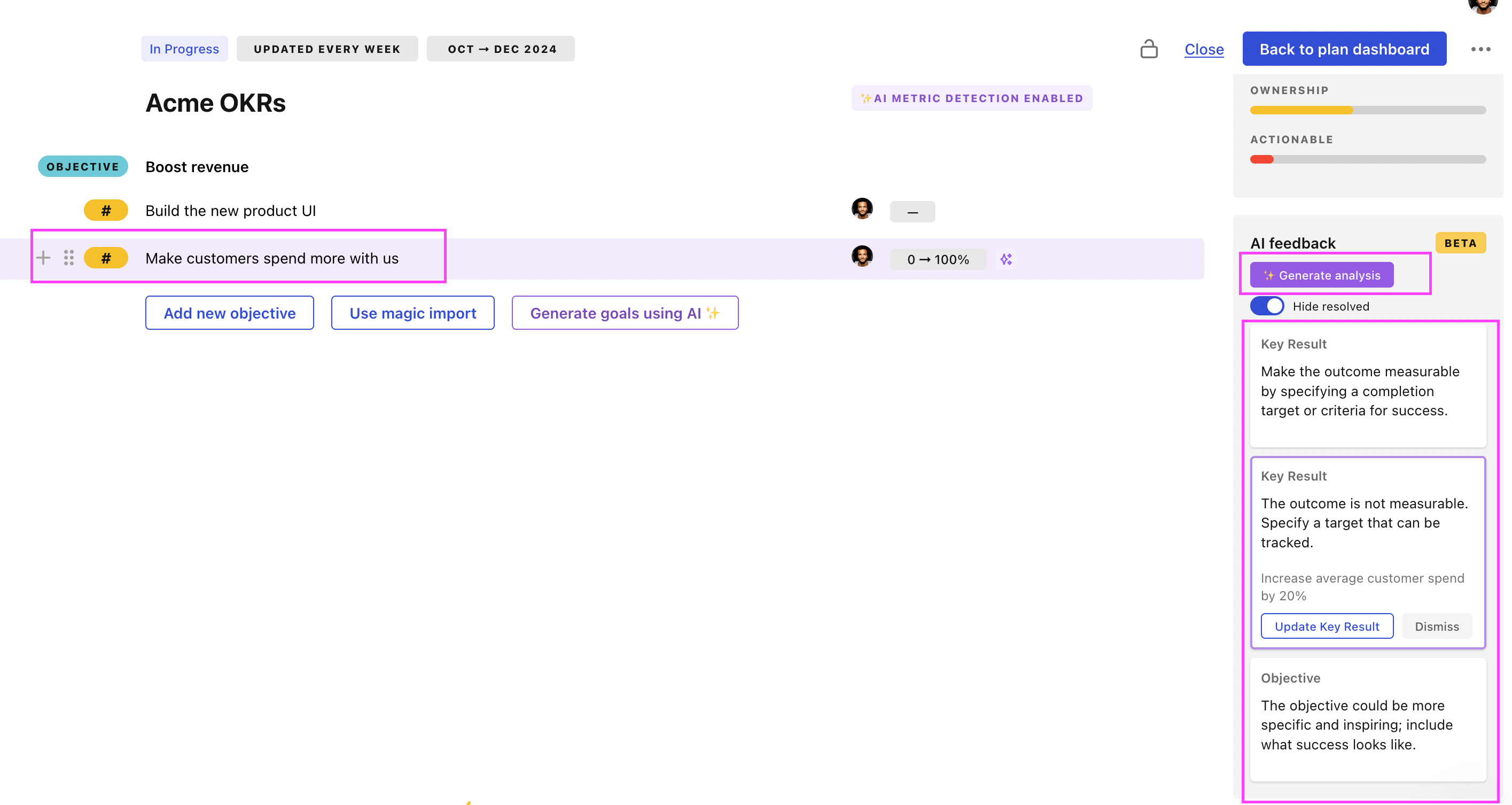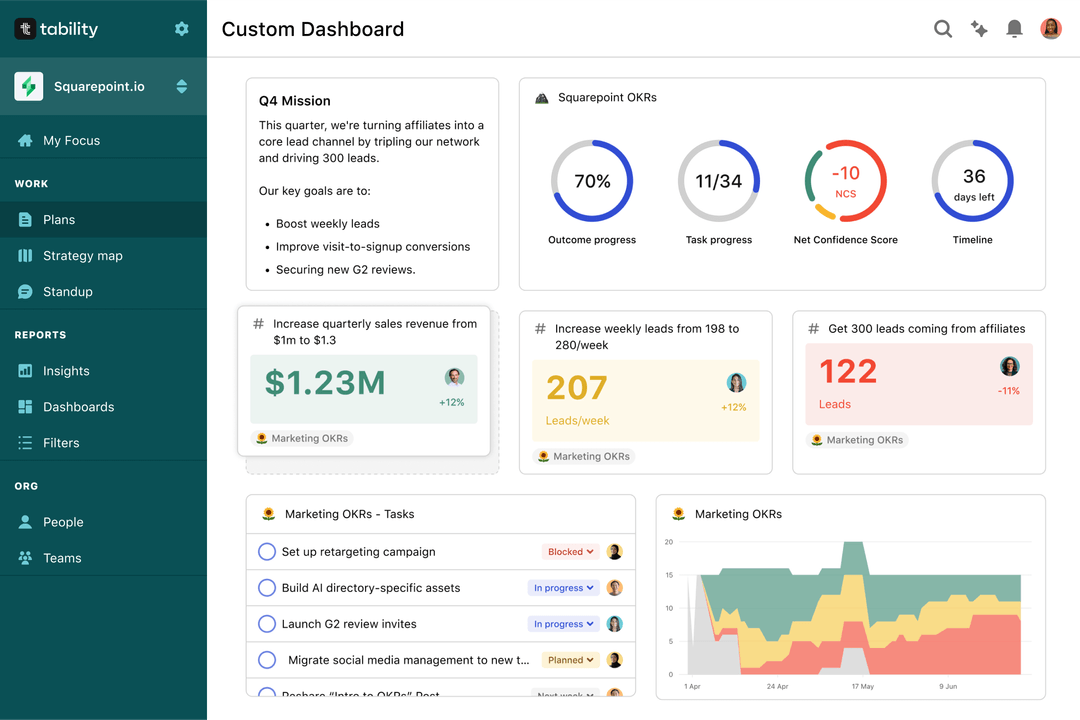Tability is a cheatcode for goal-driven teams. Set perfect OKRs with AI, stay focused on the work that matters.
What are Bot Development Team OKRs?
The Objective and Key Results (OKR) framework is a simple goal-setting methodology that was introduced at Intel by Andy Grove in the 70s. It became popular after John Doerr introduced it to Google in the 90s, and it's now used by teams of all sizes to set and track ambitious goals at scale.
Formulating strong OKRs can be a complex endeavor, particularly for first-timers. Prioritizing outcomes over projects is crucial when developing your plans.
We've tailored a list of OKRs examples for Bot Development Team to help you. You can look at any of the templates below to get some inspiration for your own goals.
If you want to learn more about the framework, you can read our OKR guide online.
The best tools for writing perfect Bot Development Team OKRs
Here are 2 tools that can help you draft your OKRs in no time.
Tability AI: to generate OKRs based on a prompt
Tability AI allows you to describe your goals in a prompt, and generate a fully editable OKR template in seconds.
- 1. Create a Tability account
- 2. Click on the Generate goals using AI
- 3. Describe your goals in a prompt
- 4. Get your fully editable OKR template
- 5. Publish to start tracking progress and get automated OKR dashboards
Watch the video below to see it in action 👇
Tability Feedback: to improve existing OKRs
You can use Tability's AI feedback to improve your OKRs if you already have existing goals.
- 1. Create your Tability account
- 2. Add your existing OKRs (you can import them from a spreadsheet)
- 3. Click on Generate analysis
- 4. Review the suggestions and decide to accept or dismiss them
- 5. Publish to start tracking progress and get automated OKR dashboards

Tability will scan your OKRs and offer different suggestions to improve them. This can range from a small rewrite of a statement to make it clearer to a complete rewrite of the entire OKR.
Bot Development Team OKRs examples
We've added many examples of Bot Development Team Objectives and Key Results, but we did not stop there. Understanding the difference between OKRs and projects is important, so we also added examples of strategic initiatives that relate to the OKRs.
Hope you'll find this helpful!
OKRs to develop an LLM chat bot
ObjectiveDevelop an LLM chat bot
KRIncrease user engagement with the chat bot by 20%
Analyze user feedback and make necessary adjustments to chat bot's performance
Improve chat bot's response speed and efficiency
Implement gamification elements to make the chat bot interaction more enjoyable
Integrate personalized recommendations based on user preferences
KRAchieve a customer satisfaction rating of at least 4.5 out of 5
Implement regular customer feedback surveys to gauge satisfaction levels
Train customer service team to improve communication and problem-solving skills
Continuously improve products and services based on customer feedback and suggestions
Address customer complaints promptly and find appropriate resolutions to their concerns
KRReduce average response time of the chat bot to under 10 seconds
Allocate more server resources to enhance chat bot performance
Regularly monitor and analyze chat bot's performance to identify areas for improvement
Train the chat bot to understand and respond to common queries more efficiently
Optimize the chat bot's algorithm to improve response speed
KRImprove accuracy of responses provided by the chat bot to 95%
Review and update chat bot's training data with relevant and reliable information regularly
Implement a feedback mechanism for users to report inaccurate responses from the chat bot
Continuously monitor user interactions and provide ongoing training to improve the chat bot's accuracy
Conduct frequent testing and debugging to identify and fix any issues in the chat bot's response generation
OKRs to implement cutting-edge bot detection technologies for website data
ObjectiveImplement cutting-edge bot detection technologies for website data
KRAchieve 95% accuracy rate in detecting bots using newly implemented technologies
Continuously refine and update the models deployed
Test algorithms with diverse sets of data
Implement new machine learning algorithms for bot detection
KRIntegrate and test 3 selected bot detection technologies on our website
Choose three suitable bot detection technologies for our website
Conduct thorough testing to ensure effectiveness
Implement these technologies into our site's backend
KRIdentify and study 10 new bot detection methods from industry research
Analyze each method's pros, cons, and applicability
Select 10 recent industry research on bot detection methods
Prepare a report summarizing findings
OKRs to to successfully launch both digital and print newsletters
ObjectiveTo successfully launch both digital and print newsletters
KRDevelop and finalize newsletter content and layout by week 4
KRObtain subscriptions from 500 unique readers by week 8
Optimize website for user-friendly subscription process
Implement a targeted marketing campaign via social media
Develop an engaging subscription offer to attract readers
KRAchieve 30% open-rate for digital newsletter by week 12
Develop engaging content with catchy subject lines
Segment and personalize your email list
Test different days and times for email sending
OKRs to build high-profit daytrading bots for NinjaTrader 8 using futures
ObjectiveBuild high-profit daytrading bots for NinjaTrader 8 using futures
KRIncrease the bot's profitability by 10% each quarter, without interruption
Implement upselling techniques in bot conversations
Enhance customer engagement to drive sales
Optimize bot operations to reduce cost and improve efficiency
KRAchieve a BOT success rate of 75% in simulation by month six
Conduct thorough simulation testing
Implement advanced bot learning algorithms
Refine bot responses based on test results
KRDesign a bot prototype and test for faults within the first three weeks
Sketch out initial bot design framework
Develop bot prototype based on sketch
Run rigorous tests to identify issues
OKRs to develop a comprehensive monolingual dictionary for both online and print use
ObjectiveDevelop a comprehensive monolingual dictionary for both online and print use
KRCompile a list of 20,000 words and their meaning by the end of the quarter
Identify reliable sources for word definitions
Allocate daily time for compiling words
Record 222 words and definitions daily
KRCoordinate the production of 200 printed copies of the dictionary
Proofread and finalize dictionary content for print
Schedule pickup or delivery of finished dictionaries
Contact printing company to negotiate price and details for 200 copies
KRDesign and test user-friendly online interface for easy dictionary navigation
Develop a prototype based on approved designs
Sketch design mockups for the dictionary's online interface
Conduct user testing and gather feedback for improvements
Bot Development Team OKR best practices
Generally speaking, your objectives should be ambitious yet achievable, and your key results should be measurable and time-bound (using the SMART framework can be helpful). It is also recommended to list strategic initiatives under your key results, as it'll help you avoid the common mistake of listing projects in your KRs.
Here are a couple of best practices extracted from our OKR implementation guide 👇
Tip #1: Limit the number of key results
Having too many OKRs is the #1 mistake that teams make when adopting the framework. The problem with tracking too many competing goals is that it will be hard for your team to know what really matters.
We recommend having 3-4 objectives, and 3-4 key results per objective. A platform like Tability can run audits on your data to help you identify the plans that have too many goals.
Tip #2: Commit to weekly OKR check-ins
Setting good goals can be challenging, but without regular check-ins, your team will struggle to make progress. We recommend that you track your OKRs weekly to get the full benefits from the framework.
Being able to see trends for your key results will also keep yourself honest.
Tip #3: No more than 2 yellow statuses in a row
Yes, this is another tip for goal-tracking instead of goal-setting (but you'll get plenty of OKR examples above). But, once you have your goals defined, it will be your ability to keep the right sense of urgency that will make the difference.
As a rule of thumb, it's best to avoid having more than 2 yellow/at risk statuses in a row.
Make a call on the 3rd update. You should be either back on track, or off track. This sounds harsh but it's the best way to signal risks early enough to fix things.
Save hours with automated Bot Development Team OKR dashboards

Quarterly OKRs should have weekly updates to get all the benefits from the framework. Reviewing progress periodically has several advantages:
- It brings the goals back to the top of the mind
- It will highlight poorly set OKRs
- It will surface execution risks
- It improves transparency and accountability
Spreadsheets are enough to get started. Then, once you need to scale you can use Tability to save time with automated OKR dashboards, data connectors, and actionable insights.
How to get Tability dashboards:
- 1. Create a Tability account
- 2. Use the importers to add your OKRs (works with any spreadsheet or doc)
- 3. Publish your OKR plan
That's it! Tability will instantly get access to 10+ dashboards to monitor progress, visualise trends, and identify risks early.
More Bot Development Team OKR templates
We have more templates to help you draft your team goals and OKRs.
OKRs to enhance AWS resilience against DDoS through PenTest, gap assessment and remediation
OKRs to enhance volunteer recruitment and retention for grant research and social media
OKRs to enhance organizational performance to high-performing standards
OKRs to enhance SaaS product development in our Tribe team
OKRs to boost enrollment of subject matter experts
OKRs to bolster and develop robust internal and external partnerships